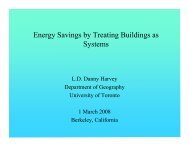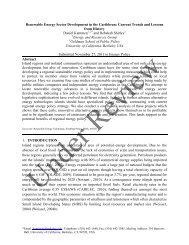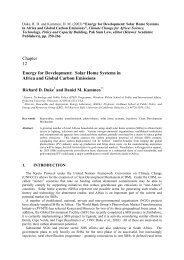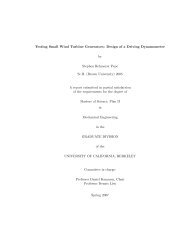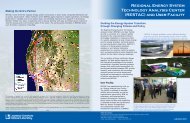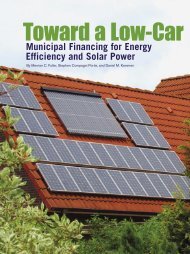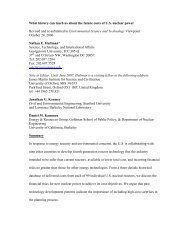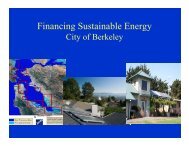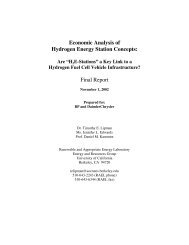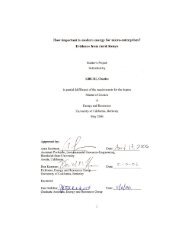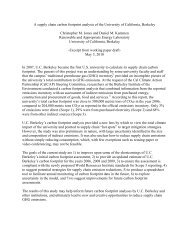Informing the Financing of Universal Energy Access: An Assessment ...
Informing the Financing of Universal Energy Access: An Assessment ...
Informing the Financing of Universal Energy Access: An Assessment ...
You also want an ePaper? Increase the reach of your titles
YUMPU automatically turns print PDFs into web optimized ePapers that Google loves.
ELECTR-5744; No <strong>of</strong> Pages 26average over <strong>the</strong> time periodbetween 2011and 2030 <strong>of</strong> USD 11.6 billionfor LDCs compared to <strong>the</strong>total estimated flow <strong>of</strong> USD 2.5billion in 2008, a gap thatis similar to o<strong>the</strong>r recentestimates. 36 It must be notedthat estimations <strong>of</strong> this gapwould increase significantlyif one were to include energyneeds that go beyond householdpoverty alleviation (or thatassume significantly higherper capita consumption overtime).F inally, considering data oninternational financial flowsand comparing <strong>the</strong>m wi<strong>the</strong>stimated requirements foruniversal energy access,implicitly suggests thatsignificant funding for energyaccess will need to be sourcedinternationally. Traditionally, <strong>the</strong>bulk <strong>of</strong> investment for a country’spower infrastructure has comemainly from domestic sources.Thus, new approaches will berequired.VI. Fur<strong>the</strong>r WorkEfficient strategies to overcomeenergy poverty in <strong>the</strong> near futurewill require <strong>the</strong> carefulconsideration <strong>of</strong> <strong>the</strong> financialvehicles needed both in terms <strong>of</strong><strong>the</strong> actual mechanisms andassociated institutions. Both areasalso require significant capacitydevelopment as a foundation.We briefly describe areas forpossible fur<strong>the</strong>r work in thoseareas. Refining <strong>the</strong> analysis: There issignificant scope for refining ouranalysis. Notably, assessingdynamic aspects could providevaluable insights <strong>of</strong> policyrelevance. Also, <strong>the</strong> paucity <strong>of</strong> <strong>the</strong>data represents a significanthindrance – especially in relationto providing insights about <strong>the</strong>relationship between macr<strong>of</strong>inancial flows and energy accessissues. Therefore, improving <strong>the</strong>information base, both in terms <strong>of</strong>quantity and quality <strong>of</strong> <strong>the</strong> data, iscrucial. Delivery mechanisms: Thisarticle demonstrates that <strong>the</strong> gapbetween current and requiredflows is enormous in severalcases. Securing politicalcommitment and putting in placeeffective policy and regulatoryframeworks are crucial elementsto improve <strong>the</strong> investment climatefor energy access. These includepolicies that are technology- orsector-specific, remove existingmarket distortions (e.g., fossil fuelsubsidies), and work acrosssectors (education, health, water,agriculture, industry), as well asfinancing mechanisms to increasefunding along <strong>the</strong> projectspectrum (e.g., pre-feasibilitystudies, feasibility studies, seedcapital, debt, equity, andinsurance). There is a growingliterature in this area, such as:UNDP, 2009; UN-<strong>Energy</strong>/Africa,undated; Kammen and Kirubi,2008; Prasad, 2008; Moner-Girona, 2009; Solano-Peralta et al.,2009; Williams and Ghanadan,2006; DB, 2010; Arc Finance, 2009;Bloomberg New <strong>Energy</strong> Finance,2010; Laan et al., 2010; MacLeanand Siegel, 2007; Morris et al.,2007; Practical Action, undated;SELCO, undated. Actors and institutionalmapping: Financial flows for <strong>the</strong>energy sector are <strong>of</strong> various types,origin and destination, and varyfrom multi-million dollarprojects for large infrastructureto <strong>the</strong> few dollars necessaryfor an improved cookstove or fora solar panel. Significantexperience has been ga<strong>the</strong>redfrom decades <strong>of</strong> successfuland less successful initiativesto address energy povertyat various levels. The lessonsshould be distilled and fedinto new strategies. Theliterature reports on some<strong>of</strong> those issues (e.g., Casillasand Kammen, 2010; Howells et al.,2010; Morris and Kirubi, 2009). Sources <strong>of</strong> financing: Theadditional financial resourcesrequired to achieve goalslike that <strong>of</strong> universal energyaccess will stem from varioussources. A useful area <strong>of</strong>fur<strong>the</strong>r investigation wouldbe to improve <strong>the</strong> understandingrelated to <strong>the</strong> share <strong>of</strong>12 1040-6190/$–see front matter # 2011 Elsevier Inc. All rights reserved., doi:/10.1016/j.tej.2011.07.006 The Electricity JournalPlease cite this article in press as: Bazilian M, have surnames. <strong>Informing</strong> <strong>the</strong> <strong>Financing</strong> <strong>of</strong> <strong>Universal</strong> <strong>Energy</strong> <strong>Access</strong>: <strong>An</strong> <strong>Assessment</strong> <strong>of</strong> Current Financial FlowsElectr. J. (2011), doi:10.1016/j.tej.2011.07.006



